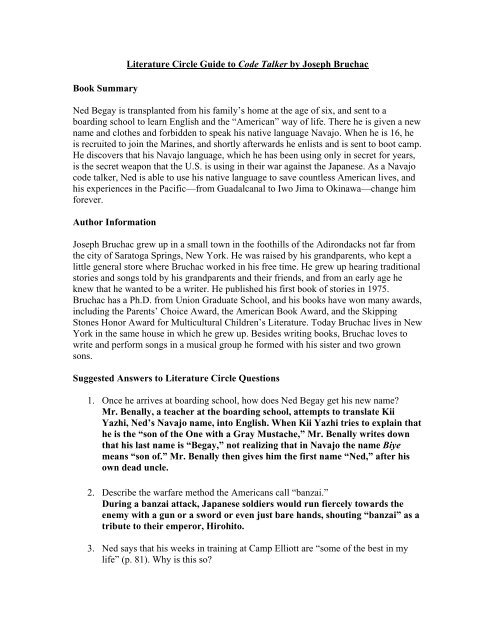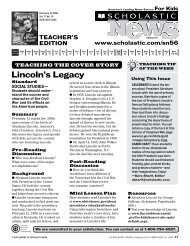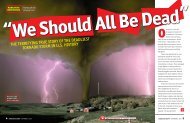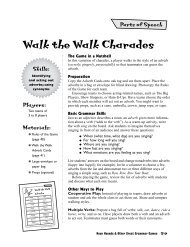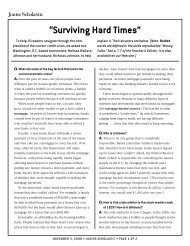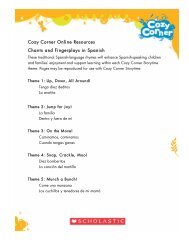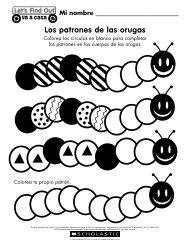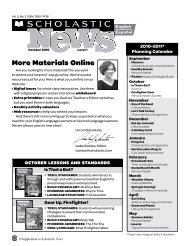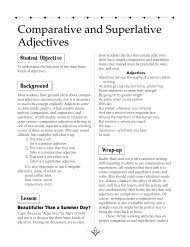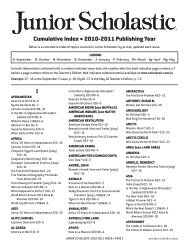Literature Circle Guide to Code Talker by Joseph ... - Scholastic
Literature Circle Guide to Code Talker by Joseph ... - Scholastic
Literature Circle Guide to Code Talker by Joseph ... - Scholastic
Create successful ePaper yourself
Turn your PDF publications into a flip-book with our unique Google optimized e-Paper software.
Book Summary<br />
<strong>Literature</strong> <strong>Circle</strong> <strong>Guide</strong> <strong>to</strong> <strong>Code</strong> <strong>Talker</strong> <strong>by</strong> <strong>Joseph</strong> Bruchac<br />
Ned Begay is transplanted from his family’s home at the age of six, and sent <strong>to</strong> a<br />
boarding school <strong>to</strong> learn English and the “American” way of life. There he is given a new<br />
name and clothes and forbidden <strong>to</strong> speak his native language Navajo. When he is 16, he<br />
is recruited <strong>to</strong> join the Marines, and shortly afterwards he enlists and is sent <strong>to</strong> boot camp.<br />
He discovers that his Navajo language, which he has been using only in secret for years,<br />
is the secret weapon that the U.S. is using in their war against the Japanese. As a Navajo<br />
code talker, Ned is able <strong>to</strong> use his native language <strong>to</strong> save countless American lives, and<br />
his experiences in the Pacific—from Guadalcanal <strong>to</strong> Iwo Jima <strong>to</strong> Okinawa—change him<br />
forever.<br />
Author Information<br />
<strong>Joseph</strong> Bruchac grew up in a small <strong>to</strong>wn in the foothills of the Adirondacks not far from<br />
the city of Sara<strong>to</strong>ga Springs, New York. He was raised <strong>by</strong> his grandparents, who kept a<br />
little general s<strong>to</strong>re where Bruchac worked in his free time. He grew up hearing traditional<br />
s<strong>to</strong>ries and songs <strong>to</strong>ld <strong>by</strong> his grandparents and their friends, and from an early age he<br />
knew that he wanted <strong>to</strong> be a writer. He published his first book of s<strong>to</strong>ries in 1975.<br />
Bruchac has a Ph.D. from Union Graduate School, and his books have won many awards,<br />
including the Parents’ Choice Award, the American Book Award, and the Skipping<br />
S<strong>to</strong>nes Honor Award for Multicultural Children’s <strong>Literature</strong>. Today Bruchac lives in New<br />
York in the same house in which he grew up. Besides writing books, Bruchac loves <strong>to</strong><br />
write and perform songs in a musical group he formed with his sister and two grown<br />
sons.<br />
Suggested Answers <strong>to</strong> <strong>Literature</strong> <strong>Circle</strong> Questions<br />
1. Once he arrives at boarding school, how does Ned Begay get his new name?<br />
Mr. Benally, a teacher at the boarding school, attempts <strong>to</strong> translate Kii<br />
Yazhi, Ned’s Navajo name, in<strong>to</strong> English. When Kii Yazhi tries <strong>to</strong> explain that<br />
he is the “son of the One with a Gray Mustache,” Mr. Benally writes down<br />
that his last name is “Begay,” not realizing that in Navajo the name Biye<br />
means “son of.” Mr. Benally then gives him the first name “Ned,” after his<br />
own dead uncle.<br />
2. Describe the warfare method the Americans call “banzai.”<br />
During a banzai attack, Japanese soldiers would run fiercely <strong>to</strong>wards the<br />
enemy with a gun or a sword or even just bare hands, shouting “banzai” as a<br />
tribute <strong>to</strong> their emperor, Hirohi<strong>to</strong>.<br />
3. Ned says that his weeks in training at Camp Elliott are “some of the best in my<br />
life” (p. 81). Why is this so?
Ned enjoys the camaraderie of life in training camp. He is recognized for his<br />
athletic skills and abilities, and he feels connected with his fellow soldiers.<br />
Also, for the first time in many years, he is allowed <strong>to</strong> speak Navajo, and even<br />
respected for being able <strong>to</strong> do so. He realizes that <strong>by</strong> knowing this language,<br />
he is able <strong>to</strong> play an important role in defeating the Japanese, and because of<br />
this he feels deeply proud <strong>to</strong> be a Navajo and a U.S. Marine.<br />
4. When Ned is terribly worried about crossing the deep waters of the Pacific Ocean<br />
in a boat, how does his friend Bill Toledo encourage him (p. 90)?<br />
Bill Toledo tells Ned, “Look up.” Bill reminds Ned that even “out on the<br />
ocean. . . Father Sky will be above us. We will never be forgotten <strong>by</strong> the<br />
sky.” He encourages Ned <strong>to</strong> find comfort and strength in his Navajo faith.<br />
5. Some of Ned’s classmates, including John Roanhorse, openly defy their boarding<br />
school teachers. Ned also disobeys his teachers, but in his own quiet way. How<br />
does Ned defy his teachers?<br />
Ned defies his teachers <strong>by</strong> speaking Navajo when he is alone with other<br />
students. He learns and teaches Navajo songs and s<strong>to</strong>ries, which he shares in<br />
private when the teachers can’t hear. He finds that boarding school makes<br />
him even more determined <strong>to</strong> hold on<strong>to</strong> his language and his culture.<br />
6. On the sign in front of Ned’s mission school is the mot<strong>to</strong>: “Tradition is the enemy<br />
of progress” (p. 23). What does this mot<strong>to</strong> mean <strong>to</strong> the teachers of the mission<br />
school?<br />
The teachers of the mission school are determined <strong>to</strong> erase all memory of<br />
Navajo cus<strong>to</strong>ms and language from their students’ memories. They believe<br />
that in order <strong>to</strong> help their students become fully integrated in<strong>to</strong> mainstream<br />
American life, they must leave behind all their Navajo traditions, including<br />
their language. The teachers teach their students that every part of their old<br />
Navajo way of life is wrong and should be discarded.<br />
7. Describing the battle of Iwo Jima, Ned says, “Our Navajo nets kept everything<br />
connected like a spider’s strands spanning distant branches” (p. 187). How does<br />
this simile describe the work of the code talkers?<br />
Like a spider’s web connecting distant branches of a tree, the Navajo code<br />
talkers connect the movements of Marine troops, directing them and<br />
warning them of danger. Their Navajo language and voices support the<br />
“web” of the troops, resulting ultimately in the U.S. vic<strong>to</strong>ry over the<br />
Japanese.<br />
8. Throughout his time in training and in service as a code talker, Ned carries a<br />
pouch of corn pollen with him. What does this pouch mean <strong>to</strong> Ned, and how does<br />
he use it?<br />
The pouch of corn pollen from his home helps Ned feel blessed and protected<br />
even though he is far from family. The pouch keeps him “calm and balanced<br />
and safe” (p. 82). He uses the pouch of corn pollen in a ritual every morning:
he <strong>to</strong>uches the pollen <strong>to</strong> the <strong>to</strong>ngue and head, then lifts it up <strong>to</strong> “the four<br />
sacred directions” as he greets the dawn. To Ned, the pouch is a<br />
remembrance of his family, home, and faith.<br />
9. Ned notices that the Navajos have a much easier time adjusting <strong>to</strong> life as Marines<br />
than the white men. Why does he feel his life as a Navajo prepared him for being<br />
a Marine?<br />
Ned says that as Indians, the Navajos are used <strong>to</strong> being shouted at and being<br />
<strong>to</strong>ld they were worthless, so they are not offended <strong>by</strong> the Marine insults.<br />
Also, the Navajos find the physical training much less challenging, since they<br />
are used <strong>to</strong> walking in the sun with heavy packs. The Navajos don’t tire as<br />
easily as the other new recruits, and they are able <strong>to</strong> wait patiently for their<br />
orders. As children in the boarding school, they had been taught at a young<br />
age how <strong>to</strong> line up and march, so this part of Marine life is easy for them.<br />
10. When First Sergeant Shinn, the Marine Corps recruiter, comes <strong>to</strong> Fort Defiance,<br />
why is Ned interested in joining the Marines?<br />
Ned is impressed with the Marine uniforms and weapons he observes in a<br />
recruiting poster, and he is most impressed with Sergeant Shinn, whom<br />
seems immediately trustworthy <strong>to</strong> Ned. Shinn tells the Navajos that if they<br />
enlist, they will have many more opportunities than if they stay on their<br />
reservation, and Ned believes him: “Looking at First Sergeant Shinn, I could<br />
see that this was indeed a man who believed in what he said. I was ready <strong>to</strong><br />
believe in it, <strong>to</strong>o” (p. 43).<br />
11. Ned mentions that the Japanese army does not follow the “rules of modern<br />
warfare” (p. 168). List three examples that support Ned’s statement.<br />
For the Japanese, being captured or surrendering in war is a great shame <strong>to</strong><br />
your nation and family, and a Japanese soldier would kill himself rather than<br />
surrender. The Japanese use banzai attacks as a major offensive tactic, even<br />
though they lose many soldiers without advancing their cause. They treat<br />
their prisoners-of-war horribly, often beating and starving their prisoners.<br />
And when they conquer native peoples of the island, they are known for<br />
being especially cruel, often killing or oppressing those they conquer.<br />
12. One of the Marine generals writes a report saying, “The Navajos have proved <strong>to</strong><br />
be excellent Marines, intelligent, industrious, easily taught <strong>to</strong> send and receive <strong>by</strong><br />
key and excellent in the field” (p. 137). Why is Ned so surprised <strong>to</strong> read this<br />
report?<br />
This news makes Ned feel like sun is shining in his heart (p. 137) because he<br />
is so used <strong>to</strong> hearing only criticism from white people <strong>to</strong>wards the Navajos.<br />
He has become so used <strong>to</strong> being judged and derided for his Navajo cus<strong>to</strong>ms,<br />
lifestyle, and language, and now instead his people are being praised for their<br />
intelligence, skill, and knowledge.
13. How would you describe the teaching methods and classroom styles of Ned’s<br />
teachers in the boarding school? What do you think of the methods Ned’s teachers<br />
use, both <strong>to</strong> teach and <strong>to</strong> discipline their students?<br />
The teachers at the mission school use public humiliation and corporal<br />
punishment <strong>to</strong> correct their students. When students use their native<br />
language, for example, their punishment is having their mouths washed out<br />
with soap. When Ned is caught speaking Navajo, he is forced <strong>to</strong> wear a dunce<br />
cap as a punishment. The mission teachers have no interest in their students’<br />
feelings or backgrounds; they are only interested in forcing their students <strong>to</strong><br />
leave behind their Navajo language and cus<strong>to</strong>ms. Most students will be<br />
appalled at the methods of Ned’s teachers, which seem extremely harsh and<br />
cruel.<br />
14. Ned survives both the hardship of boarding school and the trauma of war. How is<br />
Ned able <strong>to</strong> get through these difficulties? Which of his personal qualities do you<br />
think help him most during his trials?<br />
Ned’s inner strength and courage help him survive his hardships without<br />
bitterness. Through all his trials, he derives strength from his awareness of<br />
his Navajo heritage. His memories of his family and his faith help <strong>to</strong> sustain<br />
him: “What helped me through those times of uncertainty were thoughts of<br />
my home and family. It comforted me <strong>to</strong> know that my family was praying<br />
for me during those times” (p. 140). He is also motivated <strong>by</strong> his desire <strong>to</strong><br />
serve his country and be a credit <strong>to</strong> his Navajo people.<br />
15. In <strong>Code</strong> <strong>Talker</strong>, the character Ned Begay is telling his grandchildren the s<strong>to</strong>ry of<br />
his time spent as a Marine in World War II. How do you think Ned’s<br />
grandchildren would feel about their grandfather after hearing about his<br />
experiences? What do you think is the most important lesson that Ned’s<br />
grandchildren might learn from his s<strong>to</strong>ry?<br />
Ned’s grandchildren would be impressed <strong>by</strong> their grandfather’s integrity,<br />
bravery, and fortitude in battle, as well as his ability <strong>to</strong> forgive and live a life<br />
without bitterness in spite of the discrimination he has experienced.<br />
Note: These questions are keyed <strong>to</strong> Bloom’s Taxonomy as follows: Knowledge: 1-2;<br />
Comprehension: 3-5; Application: 6-7; Analysis: 8-10; Synthesis: 11-12; Evaluation: 13-<br />
15.<br />
Activities<br />
1. To help other students who read <strong>Code</strong> <strong>Talker</strong>, create a glossary of Navajo words<br />
and their definitions as explained in the book. You may put your words in an<br />
alphabetical list or create a set of vocabulary flash cards <strong>to</strong> share with your<br />
classmates.
The Navajo words in <strong>Code</strong> <strong>Talker</strong> are defined as they occur in the s<strong>to</strong>ry.<br />
Other students who read the novel could use the glossaries that the students<br />
create.<br />
2. Using a map of the South Pacific, trace Ned’s travels as a code talker, from<br />
Guadalcanal <strong>to</strong> Okinawa, and all the places he visited in between. Draw a small<br />
picture or symbol <strong>to</strong> show what happened at each of the locations that Ned<br />
visited.<br />
This activity will help students review Ned’s travels during the war and<br />
increase students’ familiarity with the geography of the Pacific front of<br />
World War II.<br />
3. Imagine that the character Ned Begay is a real person who will be visiting your<br />
school <strong>to</strong> talk about his experience as a code talker. Make a poster advertising<br />
Ned’s visit that will encourage your classmates <strong>to</strong> come hear him speak.<br />
This activity gives students the opportunity <strong>to</strong> summarize Ned Begay’s s<strong>to</strong>ry<br />
using text and pictures. Teachers can encourage students <strong>to</strong> highlight aspects<br />
of Ned’s character and s<strong>to</strong>ry that will most inspire their fellow classmates.


